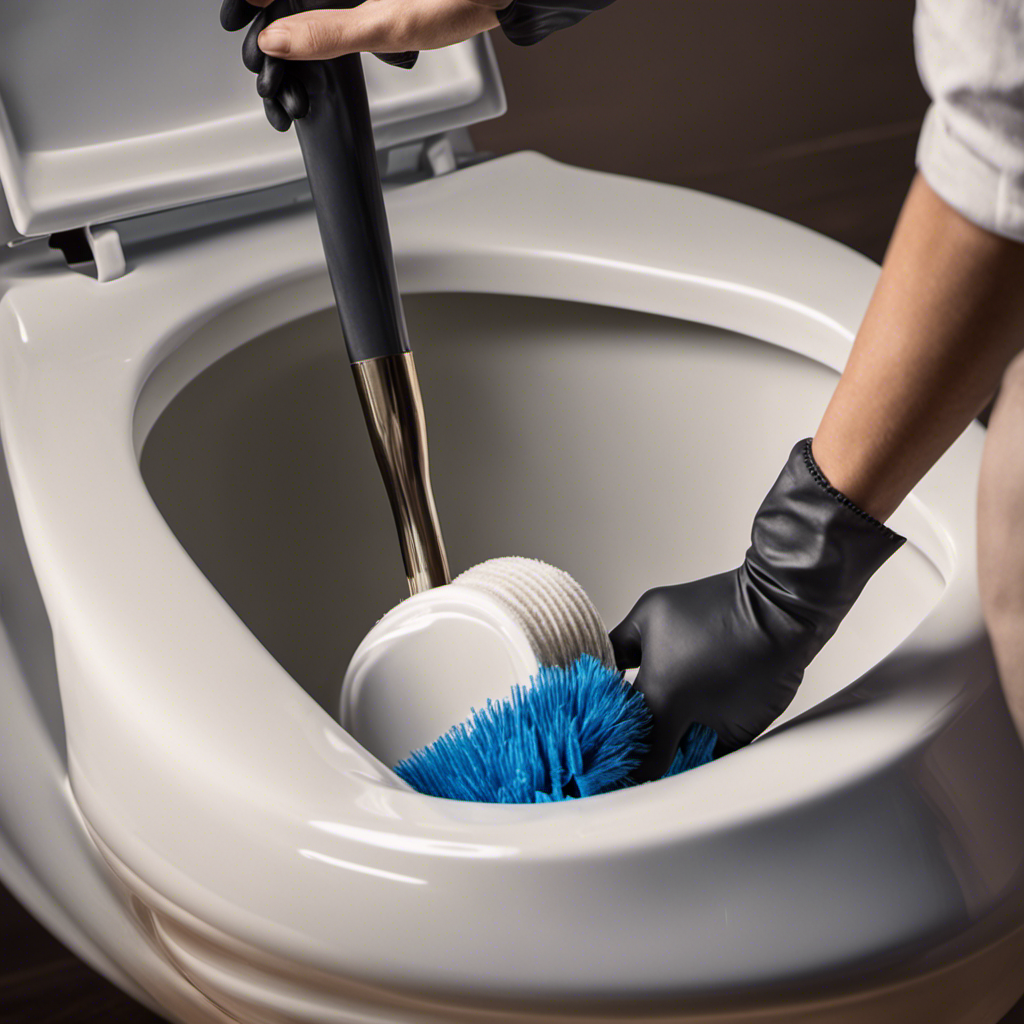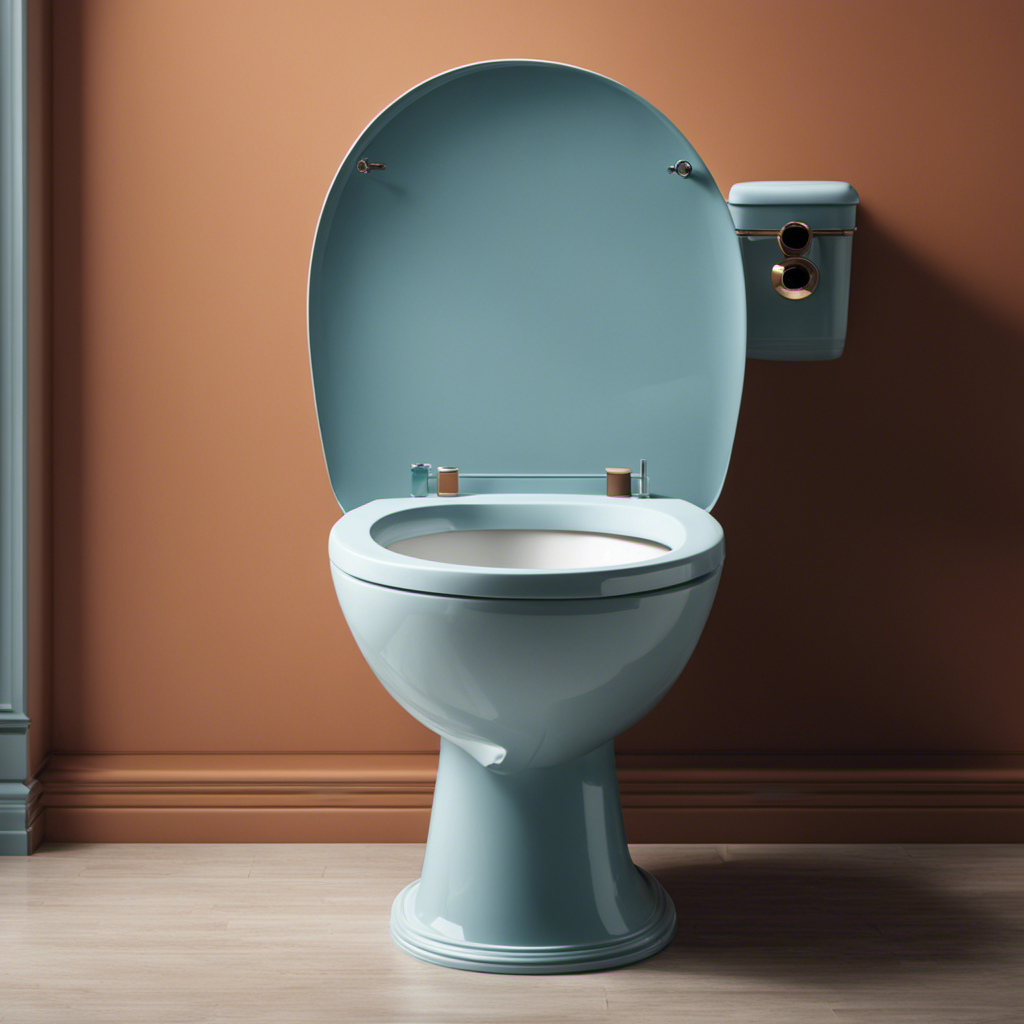I’ve discovered the ultimate secret to keeping your wooden toilet seat pristine and germ-free!
Cleaning a wooden toilet seat may seem like a daunting task, but fear not, for I am here to guide you through the process step by step.
With the right supplies and a little elbow grease, you’ll have your toilet seat looking brand new in no time.
So, let’s roll up our sleeves and dive into the world of wooden toilet seat cleaning!
Key Takeaways
- Regularly inspect the wooden toilet seat for cracks, wear and tear, and loose screws or hinges.
- Choose mild, non-abrasive cleaners and soft cloths or sponges to clean the seat, avoiding abrasive cleaners and harsh chemicals.
- Use natural cleaning solutions like lemon juice or baking soda paste for stain removal, and regularly wipe down the seat with a damp cloth.
- Sanitize the wood using a mixture of vinegar and water, and regularly clean and dry the seat to prevent the spread of germs and damage.
Assessing the Condition of the Wooden Toilet Seat
Before you begin cleaning, make sure to assess the condition of the wooden toilet seat. Evaluating the durability of the seat is essential to avoid any damage during the cleaning process. Start by checking for cracks or any signs of wear and tear. Cracks can lead to water seepage and further damage the wood. If you notice any cracks, it’s best to repair or replace the seat before proceeding.
Additionally, inspect for any loose screws or hinges that may need tightening. Once you have evaluated the condition of the seat and ensured its stability, you can move on to gathering the necessary cleaning supplies.
Gathering the Necessary Cleaning Supplies
To get started, you’ll need to gather all the necessary cleaning supplies. Cleaning a wooden toilet seat requires a few specific items to ensure a thorough and effective clean.
Here are the essential cleaning supplies you’ll need:
-
Cleaning solutions: Choose a mild, non-abrasive cleaner specifically formulated for wood surfaces. This will protect the finish and prevent any damage to the wood.
-
Soft cloth or sponge: Opt for a soft cloth or sponge to avoid scratching the wooden surface. Microfiber cloths are an excellent choice as they are gentle yet effective in removing dirt and grime.
-
Toothbrush: A soft-bristled toothbrush will come in handy for reaching into crevices and cleaning hard-to-reach areas.
-
Water: Have a bucket or basin of warm water nearby to rinse the cleaning solution and wipe away any residue.
Removing Surface Stains and Dirt
When it comes to removing surface stains and dirt from a wooden toilet seat, there are several effective techniques that can be used.
First, I recommend using a mild cleaner or a mixture of vinegar and water to gently remove stains.
For tougher stains, a paste made from baking soda and water can be applied and left on for a few minutes before scrubbing.
To maintain the longevity of your wooden toilet seat, it is important to avoid using abrasive cleaners or harsh chemicals, as these can damage the wood.
Instead, opt for natural cleaning products and regular maintenance, such as wiping down the seat with a damp cloth and applying a protective sealant every few months.
Stain Removal Techniques
First, make sure you’re using the right cleaning solution to effectively remove stains from your wooden toilet seat. Stain prevention techniques are essential to keep your wooden toilet seat looking clean and new. Here are some natural cleaning solutions you can try:
- Lemon juice: The acidity of lemon juice helps break down stains and leaves a fresh scent.
- Baking soda: Mix baking soda with water to create a paste and gently scrub away stains.
- This all-natural method is great for removing tough stains without damaging the wood.
- It’s safe for the environment and your health, making it a great choice for eco-conscious individuals.
By using these natural cleaning solutions, you can effectively remove stains from your wooden toilet seat while minimizing the use of harsh chemicals.
Transitioning into the subsequent section about cleaning products, it’s important to consider the specific cleaning products that are safe and effective for wooden toilet seats.
Cleaning Products to Use
Using the right cleaning products will ensure that your wooden toilet seat stays in good condition and free from any harmful chemicals. When it comes to cleaning techniques, it’s important to choose products that are gentle yet effective. I have compiled a list of natural alternatives that are safe for both you and your wooden toilet seat.
| Cleaning Product | Benefits |
|---|---|
| White Vinegar | Removes stains and odors, disinfects, and leaves a fresh scent |
| Baking Soda | Acts as a mild abrasive, removes grime and dirt |
| Lemon Juice | Natural bleaching agent, removes tough stains |
| Castile Soap | Gentle and non-toxic, effectively cleans without damaging the wood |
| Tea Tree Oil | Natural disinfectant, kills bacteria and germs |
These natural alternatives are not only effective in cleaning your wooden toilet seat, but they are also environmentally friendly. By using these products, you can maintain the beauty and longevity of your wooden toilet seat without compromising your health or the environment.
Now that you know the right cleaning products to use, let’s move on to the next section: maintenance tips for longevity.
Maintenance Tips for Longevity
To ensure that your wooden toilet seat lasts for a long time, it’s important to follow these maintenance tips:
- Regularly clean the seat with a soft cloth and mild soap to remove dirt and grime.
- Apply a protective finish, such as polyurethane or wax, to prevent water damage and discoloration. This will help preserve the natural beauty of the wood and extend its lifespan.
- Additionally, it will make cleaning easier by creating a barrier against stains and spills.
By taking these preventive measures, you can keep your wooden toilet seat looking great and functioning properly for years to come.
However, if stubborn stains do occur, don’t worry! There are effective methods for treating and removing them, which we will discuss in the next section. So, let’s delve into the solutions for tackling those persistent stains and bringing back the pristine condition of your wooden toilet seat.
Treating and Removing Stubborn Stains
When it comes to treating and removing stubborn stains from a wooden toilet seat, there are a few key points to keep in mind.
First and foremost, it’s important to use effective stain removal methods that will get the job done without causing any damage to the wood.
Additionally, using gentle cleaning methods is crucial to ensure that the wooden seat remains in good condition for years to come.
Lastly, proper maintenance is essential to keep the wooden toilet seat looking its best and to prevent future stains from occurring.
Effective Stain Removal
First, you’ll need to scrub the stain vigorously with a mixture of vinegar and baking soda. This powerful combination acts as a natural stain remover and will help break down and lift the stubborn marks on your wooden toilet seat. As I’ve learned through my own experiences with wooden toilet seat maintenance, this method is highly effective.
To evoke emotion in the audience, I want to emphasize the satisfaction that comes from seeing the stain gradually disappear before your eyes. Picture the sense of accomplishment as you witness the transformation and restore the beauty of your toilet seat. Imagine the relief and pride you’ll feel when your guests notice the impeccable cleanliness of your bathroom.
With this stain removal technique, you can confidently tackle any unsightly marks on your wooden toilet seat. Now, let’s explore some gentle cleaning methods to ensure the longevity of your seat.
Gentle Cleaning Methods
For a gentle approach, you can use a mixture of mild soap and warm water to keep your wooden toilet seat clean and well-maintained. This method is not only effective but also eco-friendly, as it avoids the use of harsh chemicals.
Start by filling a bucket with warm water and adding a few drops of mild soap. Use a soft cloth or sponge to dip into the soapy water and gently scrub the surface of the toilet seat. Be sure to clean both the top and bottom surfaces, as well as the hinges and screws.
Once you have removed any dirt or stains, rinse the cloth or sponge thoroughly and wipe down the toilet seat again with clean water to remove any soap residue. Finally, dry the seat with a clean towel or allow it to air dry.
Maintaining Wooden Toilet Seats
To keep your wooden toilet seat in good condition, regularly inspect it for any signs of damage or wear. This will help prevent further deterioration and prolong the life of your seat. Here are some tips to maintain your wooden toilet seat:
-
Preventing Scratches:
-
Avoid using abrasive cleaners or scrub brushes that can scratch the surface.
-
Place a soft cloth or towel on the seat before closing it to prevent scratches from the lid.
-
Polishing Techniques:
-
Use a mild wood polish or furniture wax to keep the seat looking shiny and protected.
-
Apply the polish using a soft cloth, following the grain of the wood for best results.
Sanitizing and Disinfecting the Wooden Toilet Seat
When cleaning a wooden toilet seat, make sure you sanitize and disinfect it thoroughly to maintain proper hygiene. There are various sanitizing techniques and natural cleaning methods that can be used to effectively clean a wooden toilet seat. One effective method is using a mixture of vinegar and water. Vinegar is a natural disinfectant and can help eliminate bacteria and germs. Another natural method is using baking soda. Baking soda is known for its cleaning properties and can help remove stains and odors from the wooden surface. Additionally, using a mild soap or detergent can also help in sanitizing the toilet seat. It is important to regularly clean and sanitize the wooden toilet seat to ensure cleanliness and prevent the spread of germs.
| Sanitizing Technique | Natural Cleaning Method |
|---|---|
| Vinegar and water mixture | Baking soda |
| Mild soap or detergent |
Drying and Conditioning the Wood
Regularly drying and conditioning the wood is essential to maintain the longevity and quality of the wooden toilet seat. Wood conditioning not only enhances the appearance of the seat but also prevents cracking, warping, and splitting.
To ensure the best results, follow these tips:
- Use a soft cloth or towel to wipe off any excess moisture after each use.
- Apply a high-quality wood conditioner every few months to keep the wood hydrated and prevent drying out. This will also help to maintain its natural shine and prevent fading.
- Look for products specifically designed for wood conditioning to ensure optimal results.
Maintaining and Preventing Future Stains on the Wooden Toilet Seat
To prevent future stains on your wooden toilet seat, it’s important to wipe up any spills or messes immediately. This will help prevent discoloration and protect against moisture damage.
When cleaning your wooden toilet seat, avoid using harsh chemicals or abrasive cleaners, as they can strip the protective finish and cause the wood to become dull or damaged. Instead, use a mild soap and water solution or a specially formulated wood cleaner.
Gently scrub the surface with a soft cloth or sponge, making sure to clean all crevices and corners. After cleaning, dry the seat thoroughly with a clean towel to remove any excess moisture.
To further protect your wooden toilet seat, consider applying a protective sealant or wax to create a barrier against stains and moisture.
Regular maintenance and proper cleaning techniques will help keep your wooden toilet seat looking beautiful for years to come.
Frequently Asked Questions
Can I Use Bleach to Clean a Wooden Toilet Seat?
I wouldn’t recommend using bleach to clean a wooden toilet seat. There are alternatives to bleach that are safer for wood, such as vinegar or mild soap. Bleach can potentially damage the wood and strip away its natural finish.
How Often Should I Clean My Wooden Toilet Seat?
I clean my wooden toilet seat regularly to prevent bacteria growth. It’s important to know how long it takes for bacteria to grow on a wooden toilet seat. Additionally, using a wooden seat has benefits over a plastic one.
Can I Use Oil-Based Cleaners on a Wooden Toilet Seat?
Using oil-based cleaners on a wooden toilet seat may have negative effects on the wood, such as discoloration or damage. It’s best to avoid them. Instead, opt for gentle cleaning solutions like vinegar or mild soap and water.
Is It Safe to Use Abrasive Cleaners on a Wooden Toilet Seat?
Using sandpaper on a wooden toilet seat can be effective for removing stains, but it may also damage the surface. As for abrasive cleaners, they can clean well but might scratch the wood.
Can I Use Vinegar as a Natural Cleaning Solution for a Wooden Toilet Seat?
Yes, vinegar is a great natural cleaning solution for a wooden toilet seat. It has antimicrobial properties and can effectively remove stains and odors. Plus, it’s a safer alternative to abrasive cleaners that can damage the wood.
Conclusion
As I finish cleaning my wooden toilet seat, I can’t help but feel a sense of accomplishment. The stains and dirt that once marred its beautiful surface have been banished, replaced by a renewed shine.
It’s a reminder that with a little effort and the right tools, we can transform even the most neglected areas of our lives. Just like the toilet seat, we too can undergo a process of cleansing and renewal, emerging stronger and more vibrant than before.
So let us not underestimate the power of a fresh start and the beauty that lies within it.










